9. Sound
The System of Sound Production in Man:
- In human being, the sound is produced in the voice box, called the larynx, which is present in the throat.
- It is located at the upper end of the windpipe.
- The larynx has two ligaments called ‘vocal cords’, stretched across it.
- The vocal cords have a narrow slit through which air is blown in and out.
- When a person speaks, the air from the lungs is pushed up through the trachea to the larynx.
- When this air passes through the slit, the vocal cords begin to vibrate and produce a sound.
- By varying the thickness of the vocal cords, the length of the air column in the slit can be changed.
- This produces sounds of different pitches.
- Males generally have thicker and longer vocal cords that produce a deeper, low pitch sound in comparison with females.
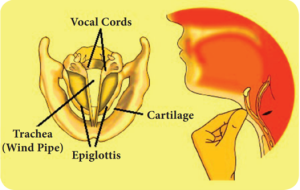
Human Ears Work:
- Ear is the important organ for all animals to hear a sound.
- We are able to hear sound through our ears.
- Human ear picks up and interprets high frequency vibrations of air.
- Ears of aquatic animals are designed to pick up high frequency vibrations in water.
- The outer and visible part of the human ear is called pinna (curved in shape).
- It is specially designed to gather sound from the environment, which then reaches the ear drum (tympanic membrane) through the ear canal.
- When the sound wave strikes the drum, the ossicles move inward and outward to create the vibrations.
- These vibrations are then picked up by special types of cells in the inner ear.
- From the inner ear the vibrations are sent to the brain in the form of signals.
- The brain perceives these signals as sounds.

Sound Waves:
- Sound needs a material medium like air, water, steel etc., for its propagation.
- It cannot travel through vacuum.
- This can be demonstrated by the Bell – Jar experiment.
- An electric bell and an airtight glass jar are taken. The electric bell is suspended inside the airtight jar.
- The jar is connected to a vacuum pump.
- If the bell is made to ring, we will be able to hear the sound of the bell.
- Now, when the jar is evacuated with the vacuum pump, the air in the jar is pumped out gradually and the sound becomes feebler and feebler.
- We will not hear any sound, if the air is fully removed (if the jar has vacuum).
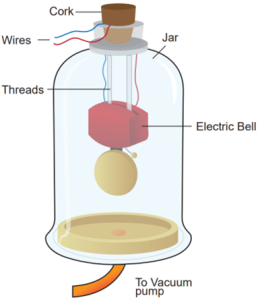
Resonances:
- An echo is the sound reproduced due to the reflection of the original sound from various rigid surfaces such as walls, ceilings, surfaces of mountains, etc.
- If you shout or clap near a mountain or near a reflecting surface, like a building you can hear the same sound again.
- The sound, which you hear is called an echo.
- It is due to the reflection of sound.
- One does not experience any echo sound in a small room.
- This does not mean that sound is not reflected in a small room.
- This is because smaller rooms do not satisfy the basic conditions for hearing an echo.
Conditions necessary for hearing echo:
- The persistence of hearing for human ears is 0.1 second.
- This means that you can hear two sound waves clearly, if the time interval between the two sounds is at least 0.1s.
- Thus, the minimum time gap between the original sound and an echo must be 0.1s.
- The above criterion can be satisfied only when the distance between the source of sound and the reflecting surface would satisfy the following equation:
Velocity = distance travelled by sound / time taken
v = 2d / t
d = vt / 2
Since, t = 0.1 second, then d = v x 0.1 / 2 = v / 20
- Thus the minimum distance required to hear an echo is 1/20th part of the magnitude of the velocity of sound in air.
- If you consider the velocity of sound as 344 ms–1, the minimum distance required to hear an echo is 17.2 m.
Applications of echo:
- Some animals communicate with each other over long distances and also locate objects by sending the sound signals and receiving the echo as reflected from the targets.
- The principle of echo is used in obstetric ultrasonography, which is used to create real-time visual images of the developing embryo or fetus in the mother’s uterus.
- This is a safe testing tool, as it does not use any harmful radiations.
- Echo is used to determine the velocity of sound waves in any medium.
Applications Reflection of Sound:
Sound board:
- These are basically curved surfaces (concave), which are used in auditoria and halls to improve the quality of sound.
- This board is placed such that the speaker is at the focus of the concave surface.
- The sound of the speaker is reflected towards the audience thus improving the quality of sound heard by the audience.
Ear trumpet:
- Ear trumpet is a hearing aid, which is useful by people who have difficulty in hearing.
- In this device, one end is wide and the other end is narrow.
- The sound from the sources fall into the wide end and are reflected by its walls into the narrow part of the device.
- This helps in concentrating the sound and the sound enters the ear drum with more intensity.
- This enables a person to hear the sound better.
Mega phone:
- A megaphone is a horn-shaped device used to address a small gathering of people. Its one end is wide and the other end is narrow.
- When a person speaks at the narrow end, the sound of his speech is concentrated by the multiple reflections from the walls of the tube.
- Thus, his voice can be heard loudly over a long distance.
Reflection of Sound:
- Sound bounces off a surface of solid or a liquid medium like a rubber ball that bounces off from a wall.
- An obstacle of large size which may be polished or rough is needed for the reflection of sound waves.
- The laws of reflection are:
- The angle in which the sound is incident is equal to the angle in which it is reflected.
- Direction of incident sound, the reflected sound and the normal are in the same plane.
Uses of multiple reflections of sound:
Musical instruments:
- Megaphones, loud speakers, horns, musical instruments such as nathaswaram, shehnai and trumpets are all designed to send sound in a particular direction without spreading it in all directions.
- In these instruments, a tube followed by a conical opening reflects sound successively to guide most of the sound waves from the source in the forward direction towards the audience.
Stethoscope:
- Stethoscope is a medical instrument used for listening to sounds produced in the body.
- In stethoscopes, these sounds reach doctor’s ears by multiple reflections that happen in the connecting tube.
Applications of reflection of sound waves:
- Stethoscope:
- It works on the principle of multiple reflections.
- It consists of three main parts:
- Chest piece: It consists of a small disc-shaped resonator (diaphragm) which is very sensitive to sound and amplifies the sound it detects.
- Ear piece: It is made up of metal tubes which are used to hear sounds detected by the chest piece.
- Rubber tube:
- This tube connects both chest piece and ear piece.
- It is used to transmit the sound signal detected by the diaphragm, to the ear piece.
- The sound of heart beats (or lungs) or any sound produced by internal organs can be detected, and it reaches the ear piece through this tube by multiple reflections.
- Echo:
- An echo is a repetition of sound produced by the reflection of sound waves from a wall, mountain or other obstructing surfaces.
- The speed of sound in air at 20°C is 344 ms–1.
- If we shout at a wall which is at 344 m away, then the sound will take 1 second to reach the wall.
- After reflection, the sound will take one more second to reach us.
- Therefore, we hear the echo aft er two seconds.
- SONAR:
- Sound Navigation and Ranging.
- Sonar systems make use of reflections of sound waves in water to locate the position or motion of an object.
- Similarly, dolphins and bats use the sonar principle to find their way in the darkness.
- Reverberation:
- In a closed room the sound is repeatedly reflected from the walls and it is even heard long after the sound source ceases to function.
- The residual sound remaining in an enclosure and the phenomenon of multiple reflections of sound is called reverberation.
- The duration for which the sound persists is called reverberation time.
- It should be noted that the reverberation time greatly affects the quality of sound heard in a hall.
- Therefore, halls are constructed with some optimum reverberation time.
Sonic Boom:
- When the speed of any object exceeds the speed of sound in air (330 ms–1) it is said to be travelling at supersonic speed.
- Bullets, jet, aircrafts etc., can travel at supersonic speeds.
- When an object travels at a speed higher than that of sound in air, it produces shock waves.
- These shock waves carry a large amount of energy.
- The air pressure variations associated with this type of shock waves produce a very sharp and loud sound called the ‘sonic boom’.
- The shock waves produced by an aircraft have energy to shatter glass and even damage buildings.
Doppler Effect:
- The whistle of a fast moving train appears to increase in pitch as it approaches a stationary listener and it appears to decrease as the train moves away from the listener.
- This apparent change in frequency was first observed and explained by Christian Doppler (1803-1853), an Austrian Mathematician and Physicist.
- He observed that the frequency of the sound as received by a listener is different from the original frequency produced by the source whenever there is a relative motion between the source and the listener.
- This is known as Doppler Effect this relative motion could be due to various possibilities as follows:
- The listener moves towards or away from a stationary source
- The source moves towards or away from a stationary listener
- Both source and listener move towards or away from one other
- The medium moves when both source and listener are at rest
- For simplicity of calculation, it is assumed that the medium is at rest. That is the velocity of the medium is zero.
- Let S and L be the source and the listener moving with velocities vS and vL
- Consider the case of source and listener moving towards each other.
- As the distance between them decreases, the apparent frequency will be more than the actual source frequency.
- Let n and n’ be the frequency of the sound produced by the source and the sound observed by the listener respectively.
- Then, the expression for the apparent frequency n’ is
- Here, v is the velocity of sound waves in the given medium.

- Let us consider different possibilities of motions of the source and the listener.
- In all such cases, the expression for the apparent frequency.
Case No. | Position of source and listener | Note | Expression for apparent frequency |
1. | · Both source and listener move · They move towards each other | · Distance between source and listener decreases. · Apparent frequency is more than actual frequency. | 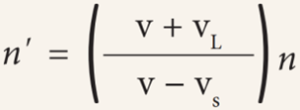 |
2. | · Both source and listener move · They move away from each other | · Distance between source and listener increases. · Apparent frequency is less than actual frequency. · vS and vL become opposite to that in case-1. | 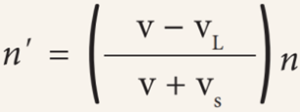 |
3. | · Both source and listener move · They move one behind the other · Source follows the listener | · Apparent frequency depends on the velocities of the source and the listener. · vS becomes opposite to that in case-2. | 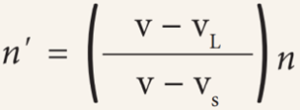 |
4. | · Both source and listener move · They move one behind the other · Listener follows the source | · Apparent frequency depends on the velocities of the source and the listener. · vS and vL become opposite to that in case-3. | 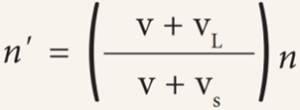 |
5. | · Source at rest · Listener moves towards the source | · Distance between source and listener decreases. · Apparent frequency is more than actual frequency. · vS = 0 in case-1. | 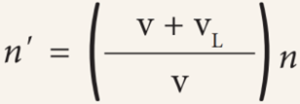 |
6. | · Source at rest · Listener moves away from the source | · Distance between source and listener increases. · Apparent frequency is less than actual frequency. · vS = 0 in case-2. | 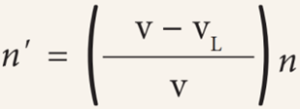 |
7. | · Listener at rest · Source moves towards the listener | · Distance between source and listener decreases. · Apparent frequency is more than actual frequency. · vL = 0 in case-1. | 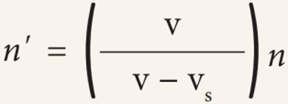 |
8. | · Listener at rest · Source moves away from the listener | · Distance between source and listener increases. · Apparent frequency is less than actual frequency. · vL = 0 in case-2. | 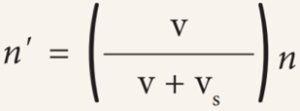 |
- Suppose the medium (say wind) is moving with a velocity W in the direction of the propagation of sound.
- For this case, the velocity of sound, ‘v’ should be replaced with (v + W).
- If the medium moves in a direction opposite to the propagation of sound, then ‘v’ should be replaced with (v – W).
Conditions for no Doppler effect:
- Under the following circumstances, there will be no Doppler effect and the apparent frequency as heard by the listener will be the same as the source frequency.
- When source (S) and listener (L) both are at rest.
- When S and L move in such a way that distance between them remains constant.
- When source S and L are moving in mutually perpendicular directions.
- If the source is situated at the center of the circle along which the listener is moving.
Applications of Doppler Effect:
To measure the speed of an automobile:
- An electromagnetic wave is emitted by a source attached to a police car.
- The wave is reflected by a moving vehicle, which acts as a moving source.
- There is a shift in the frequency of the reflected wave.
- From the frequency shift, the speed of the car can be determined.
- This helps to track the over speeding vehicles.
Tracking a satellite:
- The frequency of radio waves emitted by a satellite decreases as the satellite passes away from the Earth.
- By measuring the change in the frequency of the radio waves, the location of the satellites is studied.
RADAR (RAdio Detection And Ranging):
- In RADAR, radio waves are sent, and the reflected waves are detected by the receiver of the RADAR station.
- From the frequency change, the speed and location of the aero planes and aircrafts are tracked.
SONAR:
- In SONAR, by measuring the change in the frequency between the sent signal and received signal, the speed of marine animals and submarines can be determined.
Resonance:
- It is a special case of forced vibrations where the frequency of external periodic force (or driving force) matches with the natural frequency of the vibrating body (driven).
- As a result the oscillating body begins to vibrate such that its amplitude increases at each step and ultimately it has a large amplitude.
- Such a phenomenon is known as resonance and the corresponding vibrations are known as resonance vibrations.
- Example: The breaking of glass due to sound.
- Soldiers are not allowed to march on a bridge.
- This is to avoid resonant vibration of the bridge.
- While crossing a bridge, if the period of stepping on the ground by marching soldiers equals the natural frequency of the bridge, it may result in resonance vibrations.
- This may be so large that the bridge may collapse..
